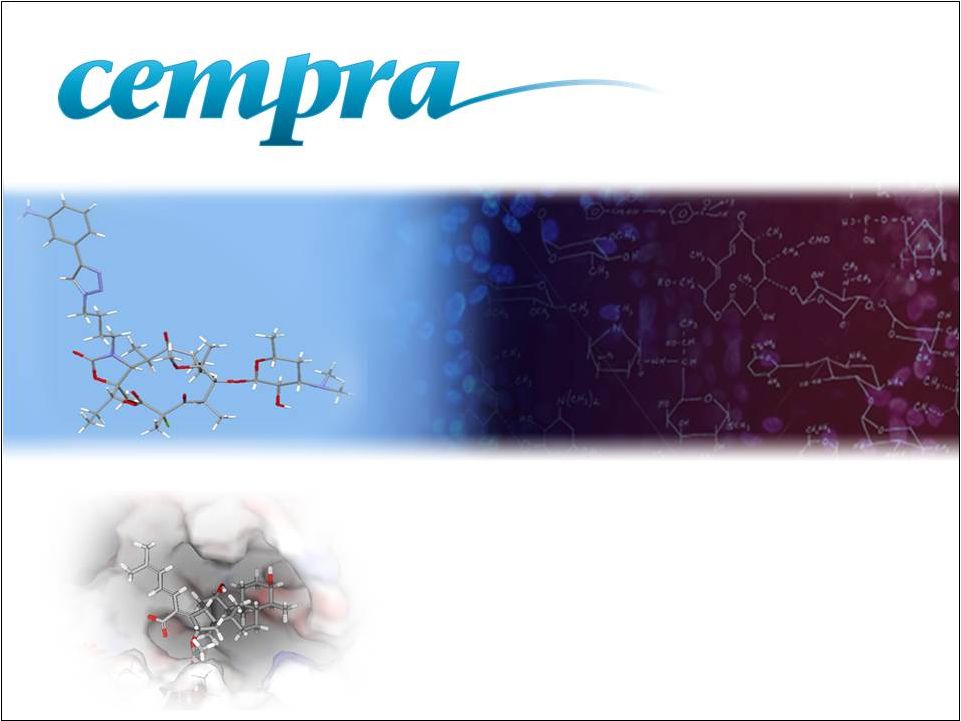 Developing Well- Differentiated Antibiotics to Meet Medical Needs Cempra Corporate Presentation Prabhavathi Fernandes, Ph.D. President & CEO June 2014 Exhibit 99.1 |
 Forward Looking Statement 2 This presentation contains forward-looking statements regarding future events. These statements are just predictions and are subject to risks and uncertainties that could cause the actual events or results to differ materially. These risks and uncertainties include, among others: risks related to the costs, timing, regulatory review and results of our studies and clinical trials; our need to obtain additional funding and our ability to obtain future funding on acceptable terms; our anticipated capital expenditures and our estimates regarding our capital requirements; our and our strategic partners’ ability to obtain FDA and foreign regulatory approval of our product candidates; our dependence on the success of solithromycin and TAKSTA; the possible impairment of, or inability to obtain, intellectual property rights and the costs of obtaining such rights from third parties; the unpredictability of the size of the markets for, and market acceptance of, any of our products, including solithromycin and TAKSTA; our ability to produce and sell any approved products and the price we are able to realize for those products; our ability to retain and hire necessary employees and to staff our operations appropriately; our ability to compete in our industry; innovation by our competitors; and our ability to stay abreast of and comply with new or modified laws and regulations that currently apply or become applicable to our business. Please refer to the documents that we file from time to time with the Securities and Exchange Commission. |
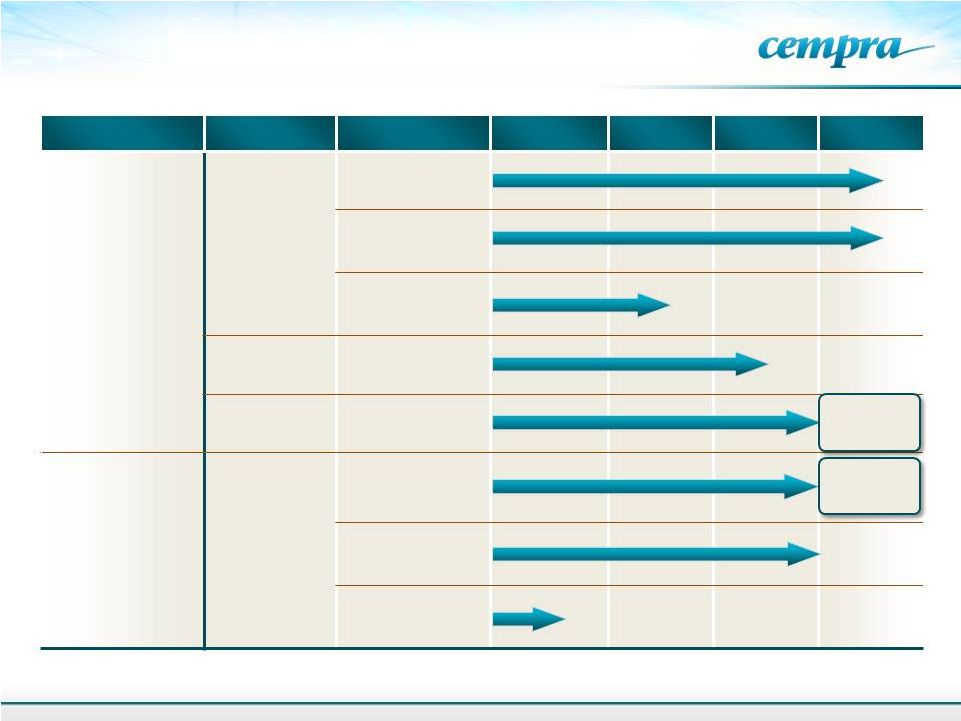 Product Indication Formulation Preclinical Phase 1 Phase 2 Phase 3 Solithromycin (CEM-101) Community Acquired Bacterial Pneumonia (CABP) Oral IV-to-Oral Oral Pediatric Biodefense Animal Rule Urethritis Oral TAKSTA Fusidic Acid Acute and Chronic Treatment of Staph (MRSA) Oral – Chronic Prosthetic Joint Infections Oral – ABSSSI Oral Suspension/ Pediatric Cempra’s Antibiotic Portfolio 3 Phase 3 to be initiated FDA Discussions TM |
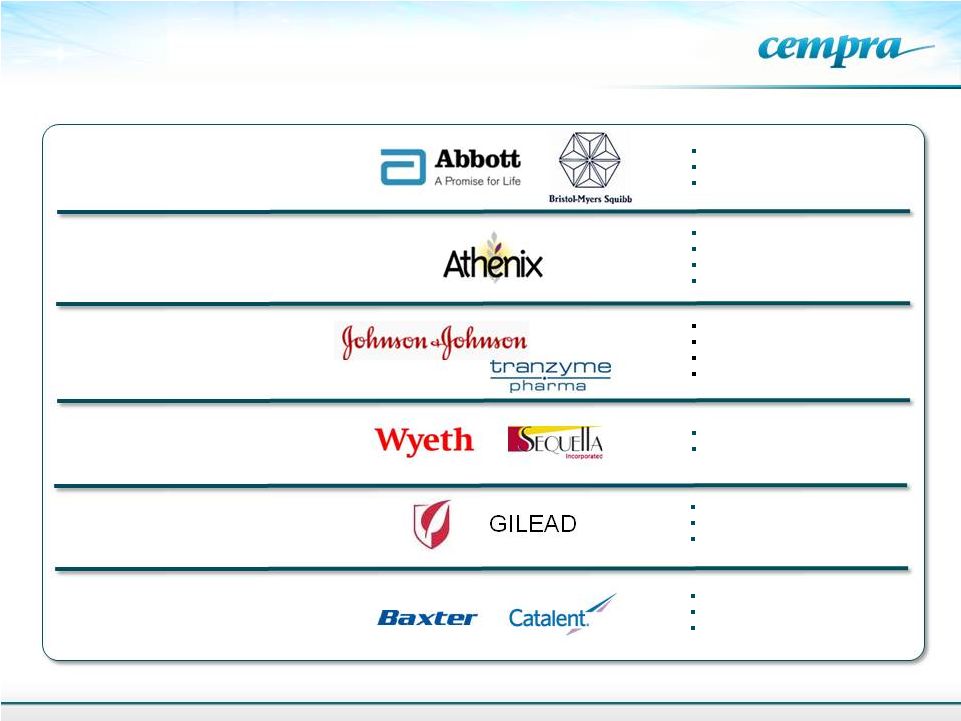 Gary Horwith, MD EVP Regulatory David Moore, MBA CCO Mark Hahn, CPA CFO David Oldach, MD SVP Clinical Prabhavathi Fernandes, PhD President & CEO David Pereira, PhD SVP Chemistry Azactam (aztreonam) Biaxin (clarithromycin) Dificid (fidaxomicin) Levaquin Topamax Ultram Nucynta Proven Management Team 4 IPO and M&A Athenix-Bayer CropScience Charles & Colvard (CTHR) E&Y S. aureus vaccine Abelcet Viread GS-9190 Combinations against HCV Injectable penicillins Dobutamine HCl injection Ranitidine injection |
 Broad Hospital and Primary Care Indications Due to resistance recurring, increasing need – Global antibiotic sales over $40B Safe antibiotics with broad use potential have historically been blockbusters, e.g., Biaxin ® , Z-Pak ® , Cipro ® , Levaquin ® , Amoxicillin Broad use requires hospital and primary care sales and marketing About 1 antibiotic prescription is written in the hospital for 9 prescriptions in the community Retail sales can be carried by large company partners More and more patients will need hospital admissions for IV therapy as out patient treatment fails owing to resistance to generic antibiotics Hospitalization is expensive and exposure to hospital acquired infections is costly and not reimbursed to hospitals Therefore there is a very important role for a new primary care antibiotic for respiratory tract infections (RTIs) that is safe and effective 5 |
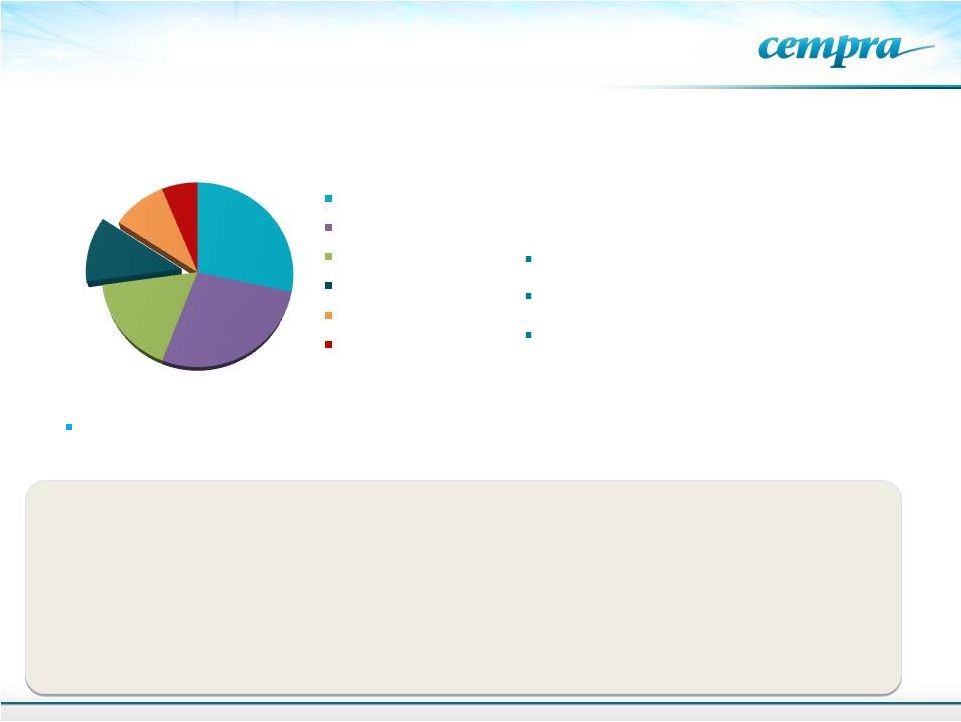 Large Macrolide Market Opportunity 6 From Hamad, B. IMS Health: Nature Drug Discovery, 9:675-676, 2010. Azithromycin, a macrolide, is the most widely prescribed treatment for CABP and other RTIs – >60% of market Global Antibiotic Sales in 2009 Total $42B Increasing resistance (40% of U.S. pneumococci a ; 96.4% in China b a Jones, RN. DMID. 2013;75:107-109; b Kim, SH. AAC. 2012;56:1418-1426.. 51 Million prescriptions were written in the US for azithromycin in the US. in 2013 Antimicrobial Resistance and Infection Control 2014: 3:16 Treatment failure of macrolide resistant pneumonia is attributed to increased cost and heathcare utilization and hospital admission Study by the Health Policy Institute, Univ. of California, Irvine. $11.9B $11.5B $7.1B $4.8B $4B $2.6B Excellent tissue/intracellular distribution and anti-inflammatory activity Good safety Cephalosporins beta-lactams Fluoroquinolones Macrolides Other antibacterials Tetracyclines / aminoglycosides Broad spectrum of activity 2013 IMS New Prescription Audit) ( |
 What is Solithromycin? Basic characteristics A 4 generation macrolide antibiotic, the first fluoroketolide – 2 Phase 3 trials Active against macrolide resistant pathogens Inhibits bacterial protein synthesis – binds three regions of the bacterial ribosome, overcoming resistance to azithromycin (Zithromax) which binds to one site only Extended spectrum of activity Best orally bioavailable macrolide, best distribution into cells and tissues Chemically stable Strong anti-inflammatory properties Clinical New oral and IV antibiotic in development in CABP – Well tolerated to date IV switch to oral provides flexibility for dosing and a pharmacoeconomic advantage TQT negative- advantage over older macrolides Demonstrated efficacy and safety in Phase 2 CABP trial – 132 patients Oral capsules, intravenous formulation and pediatric suspension in development – first in >20 years An antibiotic for all age groups, hospital as well as outpatient use 7 th |
 Solithromycin Highlights 8 Clinical Trials Phase 3 Oral, CABP study enrolling; Enrollment expected to complete Q4 2014, data expected – Q1 2015 Phase 3 intravenous-oral step down study; enrolling Phase 2 in gonorrhea completed with 100% cure in culture proven cases. Phase 3 planned to start 2H 2014 Phase 1 in pediatrics, enrolling Strategic Partnerships BARDA HHS: $58MM contract – Development of Soli for pediatric use and against bioterror pathogens Toyama Chemical (FujiFilm): Global development program – exclusive license for Japan. $10MM upfront; up to $60MM in milestones; tiered royalties based on sales Regulatory & IP Qualified Infectious Disease Products (QIDP) granted by FDA designations; oral and IV formulations for CABP Provides priority review – 8 months Only QIDP drug in CABP QIDP for gonorrhea NCE patent to 2025, additional patents and PTEs |
 Solithromycin’s Broad Use Potential HAP, Simple RTI’s, Pharyngitis, Sinusitis, Bronchitis, Acute Exacerbation of Chronic Bronchitis (AECB) Respiratory Tract Infections (RTI) Antibacterial and Anti-inflammatory COPD, Cystic fibrosis, Panbronchiolitis, NASH Special Populations BARDA funded Pediatrics and Pregnancy No pediatric drug with broad potential in development Infections in pregnancy – neonatal sepsis Infections In Utero – Premature, Cerebral palsy, Autism Biodefense BARDA funded Multiple Unidentified Pathogens Anthrax, Tularemia Sexually Transmitted Diseases Genital Infections Major public health crisis – multi drug resistance, no oral therapy. Most common reportable infectious diseases Primary cause of infertility in white women Infertility, PID GI & Others Ophthalmic Helicobacter gastritis, Campylobacteria, tick and insect borne diseases, diarrhea, and ophthalmic drops CABP Primary Indication Other Infections 9 |
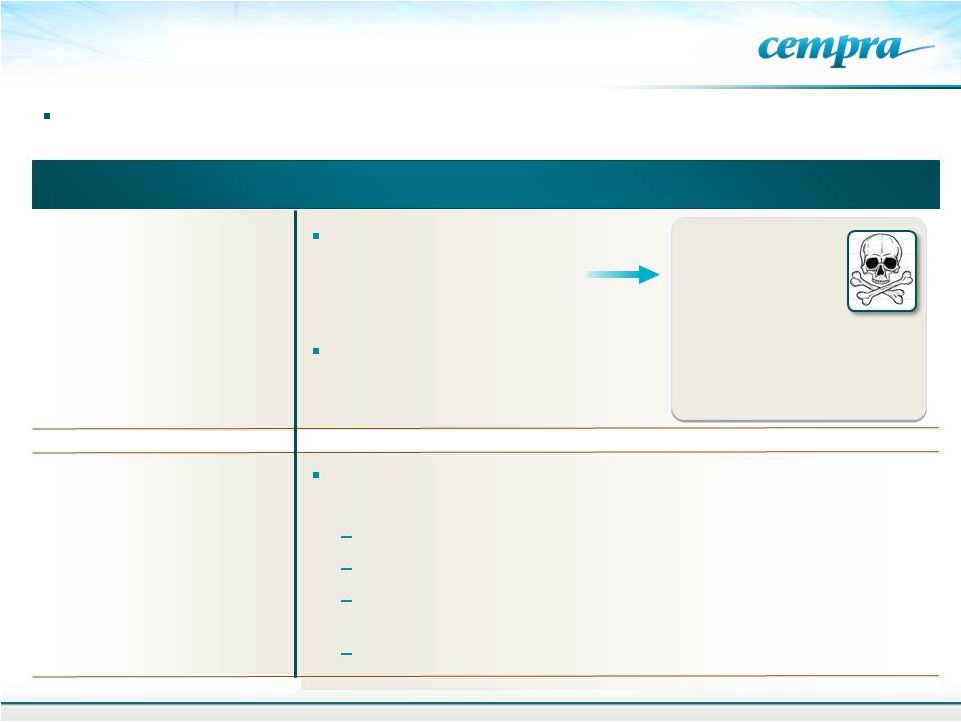 10 Why is a New Antibiotic Needed for CABP? Current IDSA/ATS recommendation to give broad spectrum coverage: In clinical practice a definitive microbial diagnosis of CABP is not feasible leading to empiric therapy to provide broad spectrum coverage Requires intravenous cephalosporin (e.g., ceftriaxone) and hospitalization Azithromycin added to treat Legionella and Mycoplasma. Pneumoccocci can be resistant Mortality rates in hospitalized CABP patients is 23% – 30-day rate a a Freeman, MK. CABP: A Primer for Pharmacists: US Pharmacist. July 1, 2013. IV and Oral available – and have broad spectrum activity, however, they are not in favor for treating CABP because: Treatment failures from resistant strain selection Kill bowel flora – associated with C.difficile colitis Adverse tendonitis, Achilles tendon rupture, hepatotoxicity and peripheral neuritis, retinal detachment Not approved for use in pediatrics Or 1) A ß-lactam plus a macrolide 2) A fluoroquinolone (e.g., Levaquin, Avelox) |
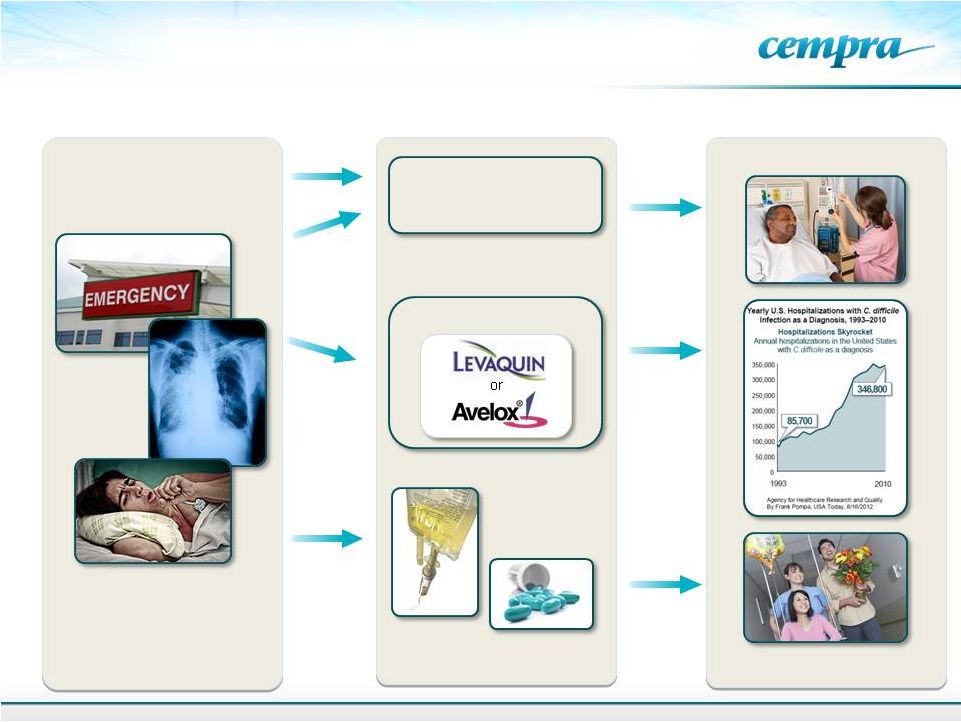 A Fluoroquinolone Current and Future Treatment of CABP 11 Hospital / IV 7–10 Days or Indication Treatment Implication Ceftriaxone plus Azithromycin Current Treatment Options Future Options With Soli IV-Oral Step-down Therapy Fewer Hospital Days Use Leads to Higher C. diff Incidence |
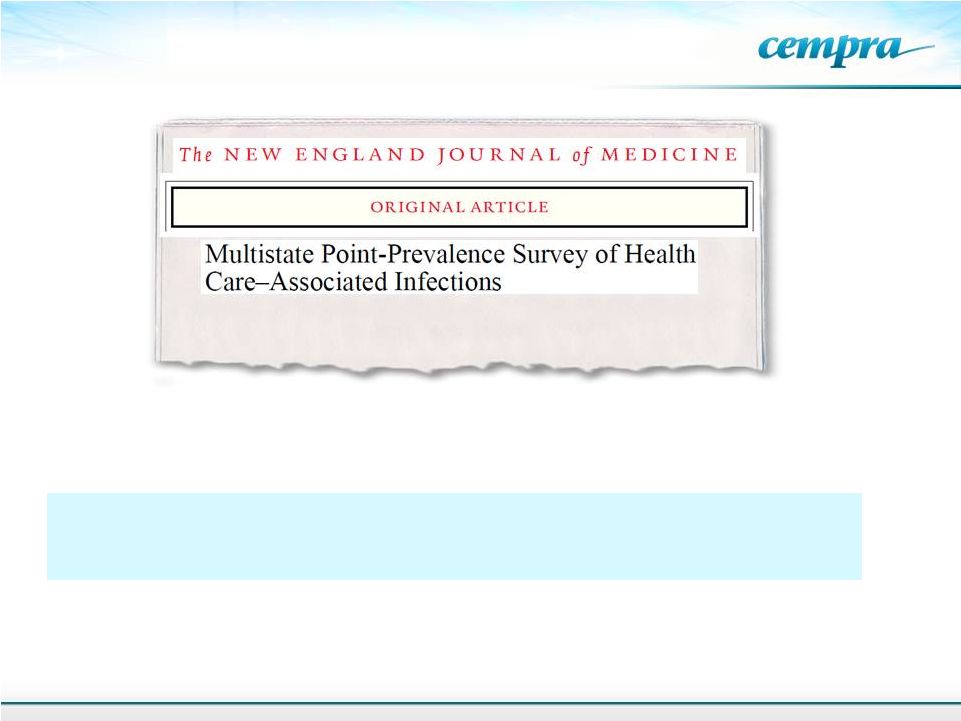 Problem of Hospital Acquired Infections 12 NEJM 2014. 1198-1208, 2014 Magill, SS. And CDC and Emory Authors 2013 National Prevention Target – 30% reduction in C. difficile ( Srinivasan, CID 2012; 55426-31 - Not on target Of all health-care associated infections- C. difficile caused by fluoroquinolone and broad spectrum antibiotics was ranked #1 |
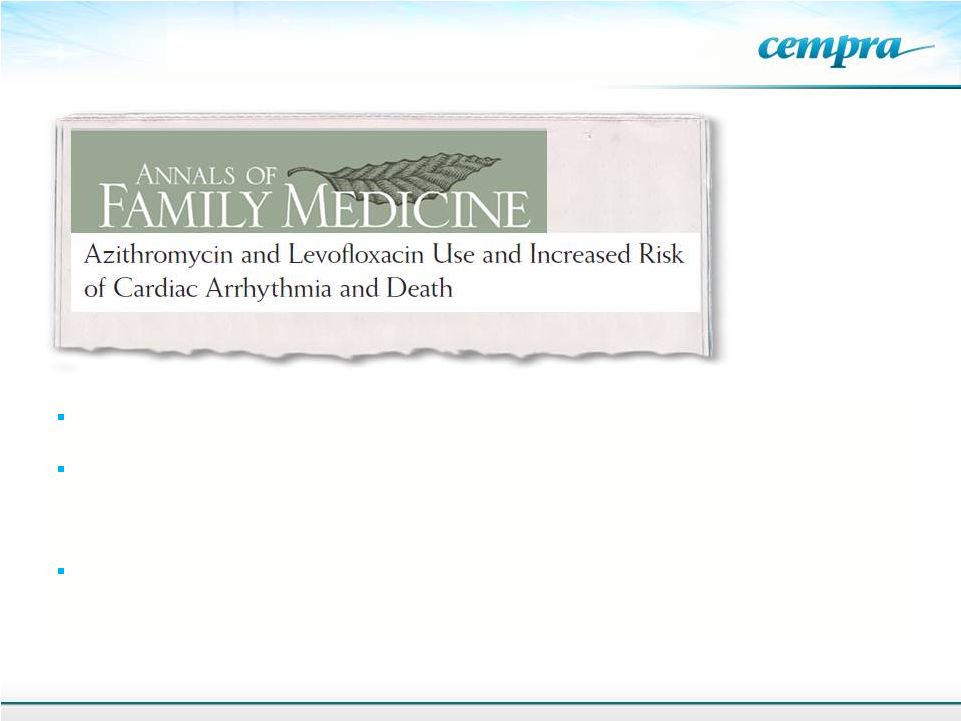 13 Large VA study - 14 million unique persons, between Sept. 1999, and April 2012. Veterans who received azithromycin 48% higher death rate and a 77% higher risk of cardiac arrhythmias in the first 5 days of treatment when compared to amoxicillin. Those who received levofloxacin had a 149% and 143% higher risk of death and cardiac arrhythmia than amoxicillin–treated patients in the first 5 day with higher rates as the duration of treatment increased. Reports of Cardiac Arrhythmias - Azithromycin and Levofloxacin are No Longer Preferred Options Ann.Fam Med 12:121-127, 2014 Gowtham A. Rao, M.D.., Ph.D., MPH, et al. |
 Community Acquired Bacterial Pneumonia (CABP) – #1 cause of death from an infection The 6th most common cause of death from all causes in the U.S. and a leading cause of death worldwide 5 to10 million CABP cases annually, 1.1 million patients hospitalized per year More common in older adults ( >65 years) and young children (CABP infection rate ranges from 74–92 ( <2yrs) and 33–52 (3–6 yrs) per 1,000 children a, b ) Appropriate empiric therapy is critical to positive outcomes Multiple pathogens can be involved - Pneumococcus – the most frequent cause CABP – Most Frequent Infectious Disease in the U.S. 14 Pneumococcal infections cause more deaths per year in U.S. than breast or prostate cancer. Xu, et al. Deaths: Final Data for 2007. Natl Vital Stat Rep. 2010;58:1-51. Respiratory disease incidence is increasing; growing numbers of COPD and asthma patients. Drug Discovery News, May 2012. a Freeman, MK. CABP: A Primer for Pharmacists.:US Pharmacist. July1, 2013. b Ostapchuk, M. et.al. American Family Physician. 2004;70:899-908 . a |
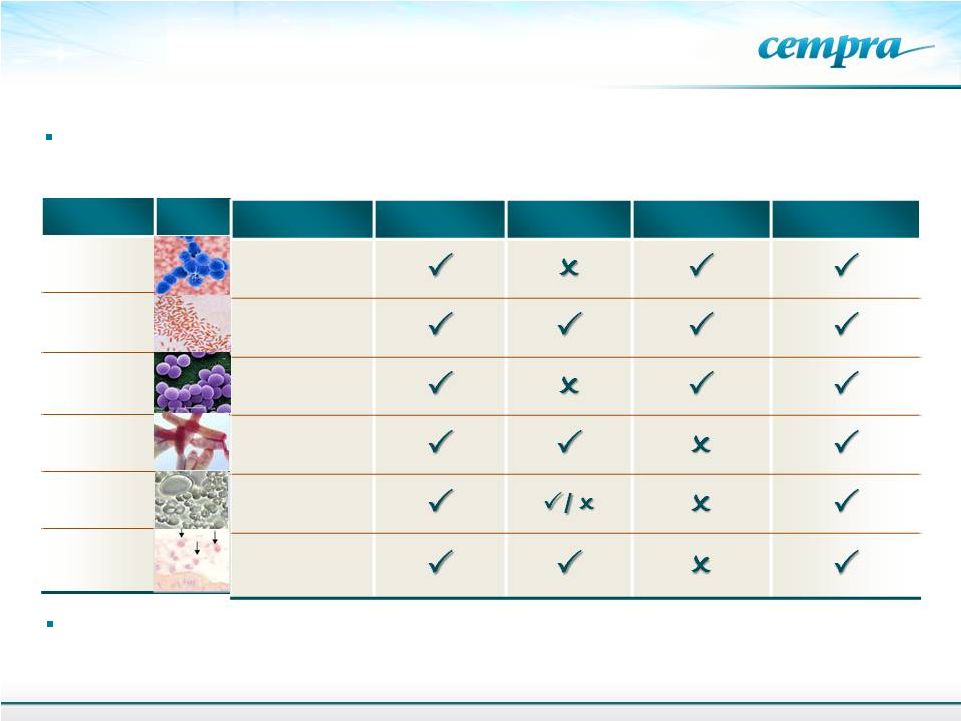 Solithromycin – Spectrum of Activity that Addresses CABP Pathogens Solithromycin has class leading potency and spectrum in vitro against CABP pathogens 15 Interacts with bacterial ribosome at three sites – Resistance rare and it could only occur if mutations occur at three distinct sites Gram Positive Negative Positive Atypical Atypical Atypical Streptococcus pneumoniae Haemophilus influenzae Staphylococcus aureus Legionella pneumophila Mycoplasma pneumoniae Chlamydophila pneumoniae Organisms Solithromycin Azithromycin Cephalosporin Fluoroquinolone |
 Why We Need a New Macrolide 16 Susceptibility data for solithromycin and comparators against 927 S. pneumoniae from RTI Samples Collected in 2012-2013. Morrissey, I. ECCMID 2014. Abstr. P1584. Antibiotic Region Percentage MIC (µg/mL) S R 90% Solithromycin Europe (418) 100 0 0.06 NA (380) 100 0 0.25 Asia (129) 100 0 0.5 Azithromycin Europe (418) 71.3 28.0 > 1 NA (380) 56.3 42.6 > 1 Asia (129) 28.7 70.5 > 1 |
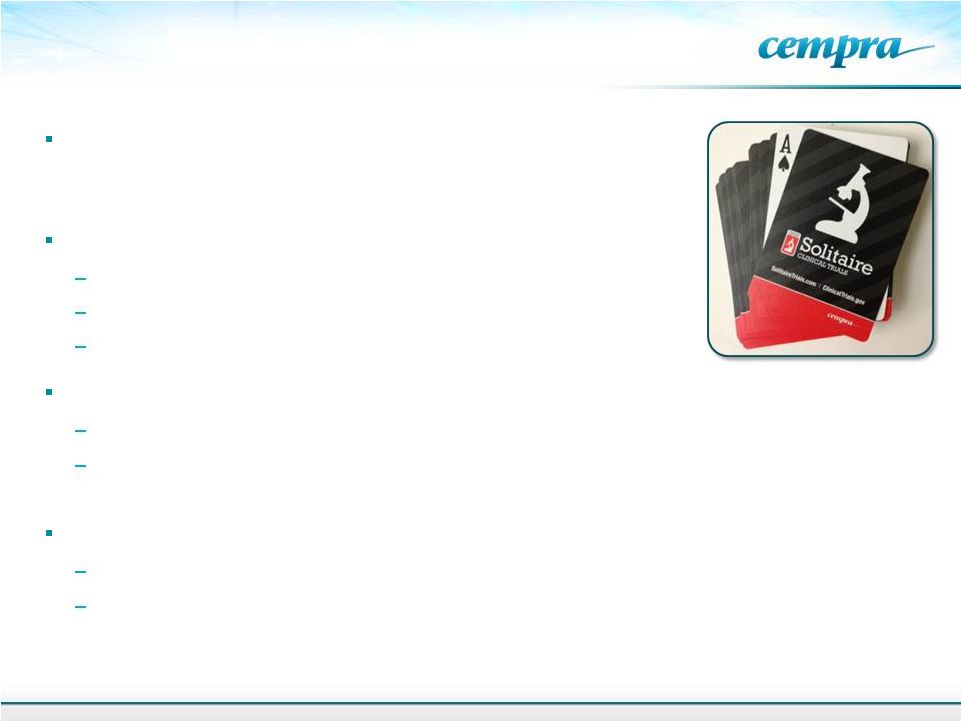 Solithromycin: Phase 3 CABP Studies Combined safety and efficacy data from two CABP Phase 3 studies is expected to be sufficient for capsules and intravenous NDA Phase 3 study 1: SOLITAIRE Oral study currently enrolling Initiated Dec 2012, enrollment expected to complete 4Q 2014 800mg LD/400mg – total 5 days vs. Avelox 400 mg 7 days Top line results expected in Q1 2015 Phase 3 study 2: SOLITAIRE Intravenous to step down oral Initiated 4Q 2013. Enrolling 400 mg IV followed by oral 800 mg LD/400 mg for up to 7 days vs. Avelox 400 mg IV to oral 7 days Both Phase 3 studies are global studies Plan to enroll ~800 patients Comparator Avelox (moxifloxacin) – A fluoroquinolone that is used worldwide at same dose 17 |
 Gonococcal Surveillance Project, US. 2006-2011. Expanding Solithromycin Use Gonorrhea Studies Current treatment – IM ceftriaxone No oral drug to treat partners The second most common communicable disease QIDP granted for solithromycin for gonorrhea treatment CDC and WHO list as urgent need Soli Phase 2 results: culture negative cure in 100% (all body sites) of evaluable patients Phase 3 planned to be initiated 2H 2014 – Shared costs of study by Australian public health A single Phase 3 study is expected to be sufficient for FDA approval Oral Cephalosporins No Longer a Recommended Treatment for Gonococcal Infections 2006 2007* 2008* 2009 2010 2011 † 0 0.5 1.0 1.5 2.0 2.5 Cefixime Ceftriaxone Year 18 Lancet ID 13: 728-730, 2013 …….A new drug on the horizon is the fluoroketolide solithromycin, to which N gonorrhoeae is very sensitive in vitro, and this agent is currently in pneumonia trials…… The second most common communicable disease |
 Pediatrics Studies – Suspension formulation Developed (BARDA funded) 19 First NCE since azithromycin to be developed as a suspension formulation for pediatric Oral drugs are even more important in pediatrics. About 80M prescriptions are written for pediatrics in the US alone When children get MDR infections, most commonly respiratory infections, what do we have left? Amoxicillin 1972, Azithromycin 1988 Solithromycin is being developed for pediatric use because of its oral bioavailability, safety and tolerability profile, stability in suspension Otitis media is the most common reason for pediatric antibiotic prescription 2013 IMS New Prescription Audit Solithromycin is effective in the chinchilla model of experimental otitis media which has been found to consistently correlate with subsequent clinical trials in children |
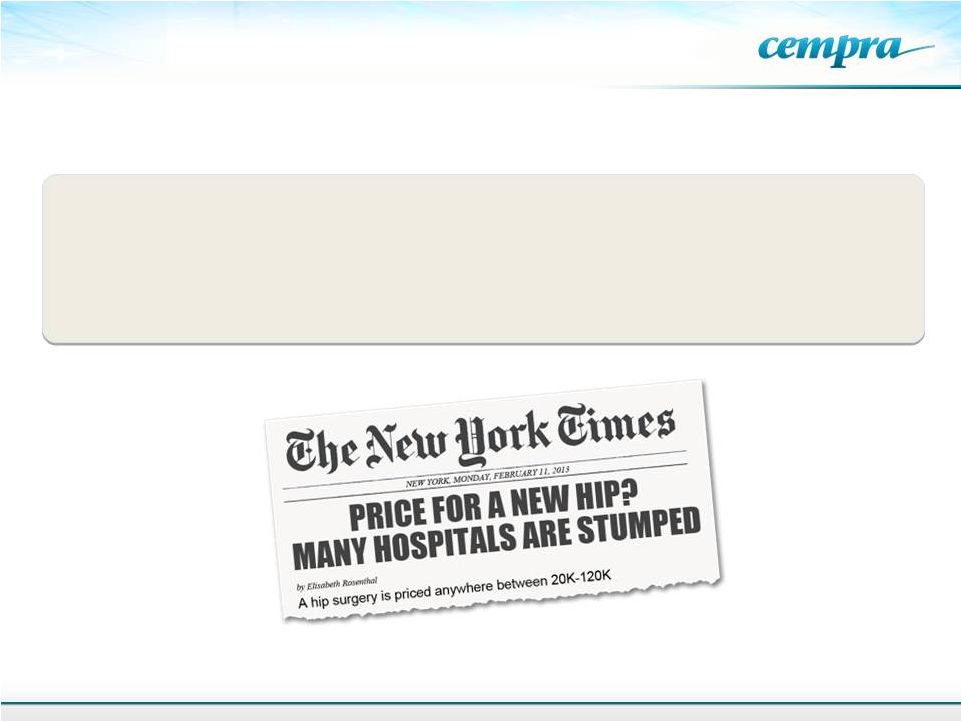 TAKSTA™ (Fusidic Acid) 20 An Oral Antibiotic for MRSA Infections Being Developed for Chronic Use in Prosthetic Joint Infections in the U.S. |
 TAKSTA Cempra’s proprietary fusidic acid dosing regimen Fusidic acid approved in Western Europe, Australia, and other countries 40 years of established safety and efficacy profile in acute and chronic use in staph infections ex-U.S. Unique structure, no known cross resistance with any other antibiotic Orally bioavailable Targeted against gram-positive pathogens, including MRSA – pathogens that causes bone and joint infections requiring long-term treatment Exclusivity NCE in the U.S.: Hatch Waxman exclusivity, 5 years obtained by Cempra, exclusive supply agreement of drug substance – a fermentation product GAIN Act adds an additional 5 years of data exclusivity – A minimum of 10 years of data exclusivity or 12 years if Orphan Loading dose patent Protects U.S. Market Exclusivity to 2029 + patent term extension Orphan Drug Designation for PJI granted – October 2013 What is TAKSTA™? 21 |
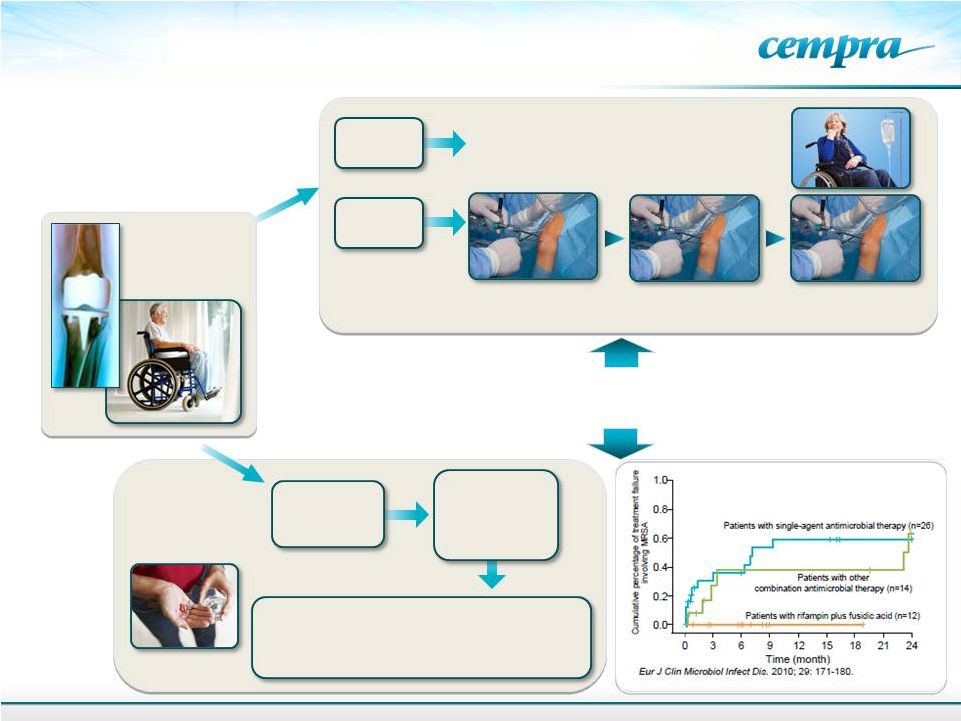 Current and Future Treatment of Prosthetic Joint Infections 22 IV Vancomycin and Oral Antibiotics – 4–6 Weeks Surgery Spacers In Surgery New Prosthesis Inserted Cempra’s Trial Current U.S. Treatments Surgery Sterile Joint Potential for Cost Savings, Surgery Decrease, Patient Comfort and Pharmacoeconomic Advantages Gain Physician, Payor Acceptance Cempra Aims to Bring the Lower Cost, More Effective European PJI Treatment Paradigm to the U.S. Debride and Treat Two-stage Revision Debride, IV Vancomycin for 1–7 Days Oral Fusidic Acid Plus Oral Rifampin for 6–12 Months Orthopedic Surgery |
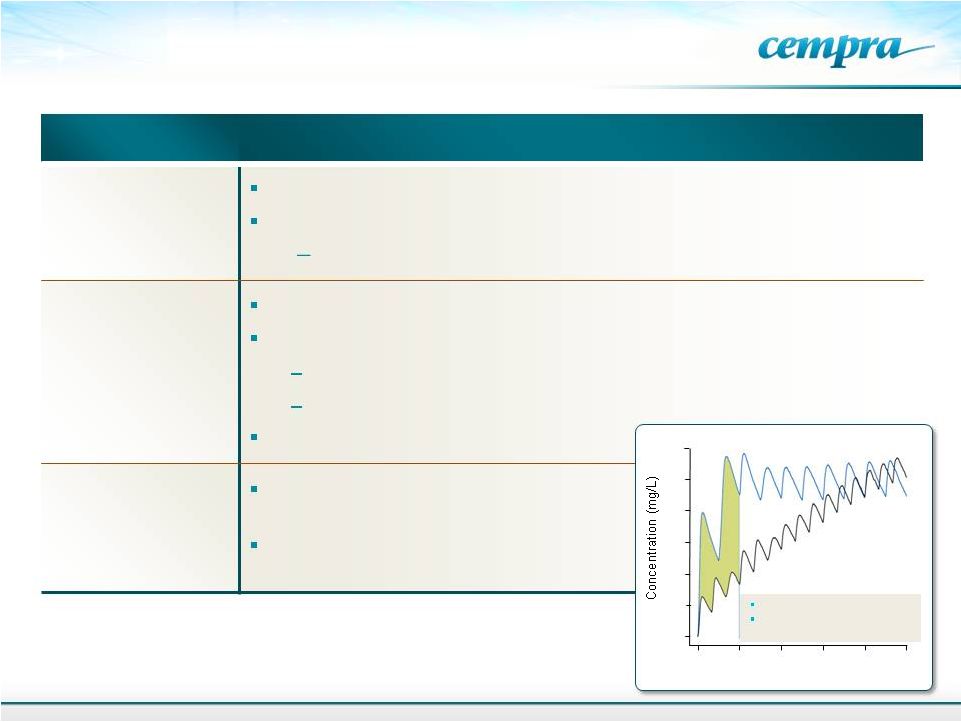 Taksta Update 23 0 20 40 60 80 100 120 European dosing Cempra’s loading dose 0 24 48 72 96 120 Time (hrs) EU Dose 500 mg dose Cempra dose 1200 mg Q12h Day followed by 600 mg Q12h Clinical Trials Phase 2 PJI study data reported, study stopped New strategy for the pivotal study is being designed No PJI guidance - Discussion with FDA planned Regulatory Orphan Drug Designation for PJI granted by FDA (October 2013) Orphan Drug designation benefits 7 year exclusivity Tax credit for 50% of clinical trial cost and PDUFA fees exempted GAIN pathogen MRSA-Potential QIDP Intellectual Property Loading dose patent protection into 2029 and PTEs Well tolerated in ABSSSI Phase 2 study; no resistance seen |
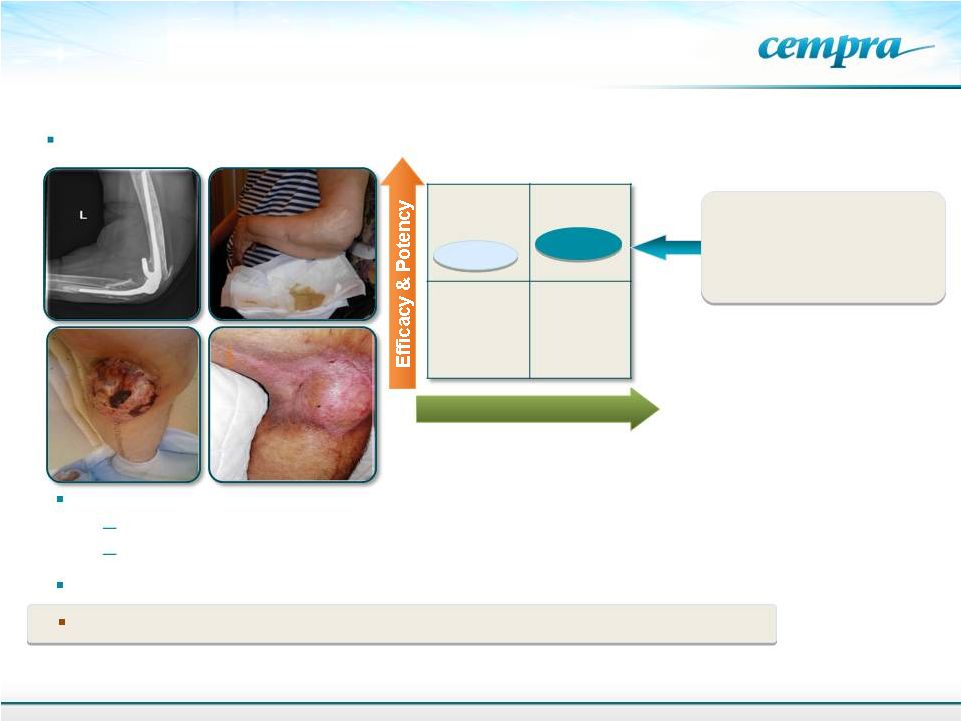 Two compassionate use cases of bone/prosthesis infections in North America Safety Linezolid TAKSTA Prosthetic surgery facts 20,000 hip and knee PJIs in 2007 a Total joint and hardware procedures – 3,286,000/year b,c Potential use in osteomyelitis, septic arthritis, and diabetic foot TAKSTA for Chronic Use in Prosthetic Joint Device (PJI) Infections 24 a N Engl J Med 2009;361:787-794. b Life Science Intelligence market research report. U.S. Markets for Large Replacement Technologies in 2012. March, 2012. c Life Science Intelligence market research report. U.S. Markets for Small Joint Implants and Hardware for the Extremities. January, 2012. Cempra’s Phase 2 PJI study closed- strategizing for pivotal study Useful for Oral Chronic Use in All Patient Populations |
 Achieved and Projected Milestones 1Q 14: QIDP designation by FDA for solithromycin for gonorrhea 1Q 14: Negative TQT results for solithromycin 1Q 14: Pediatric trial initiated for solithromycin 2H 14: Meet with FDA to define pivotal study for Taksta 2H 14: Initiate Phase 3 gonorrhea study 1Q 15: Data expected SOLITAIRE Oral Phase 3 CABP 25 |
 Take Away Notes Solithromycin is being developed as adult oral, intravenous and pediatric formulations. If Phase 3 data shows safety and efficacy, it could allow broad use of solithromycin like older macrolides Last antibiotic with oral, intravenous and pediatric suspension is azithromycin 51 million prescriptions were written last year in the US for azithromycin A new macrolide with activity against resistant strains and improved safety is needed Solithromycin – 4 th generation macrolide antibiotic, the first fluoroketolide Unlike azithromycin, monotherapy for CABP Well tolerated to date. Negative in TQT study IV switch to oral provides flexibility for dosing and a pharmacoeconomic advantage Late-stage clinical development -Enrollment in the oral Phase 3 trial expected to complete in 2014 26 |
 Cash & Equivalents (3/31/14) $79.6MM Long-Term Debt (3/31/14) $12.5MM Shares Outstanding (6/2/14) 33.2MM Capitalization 27 |
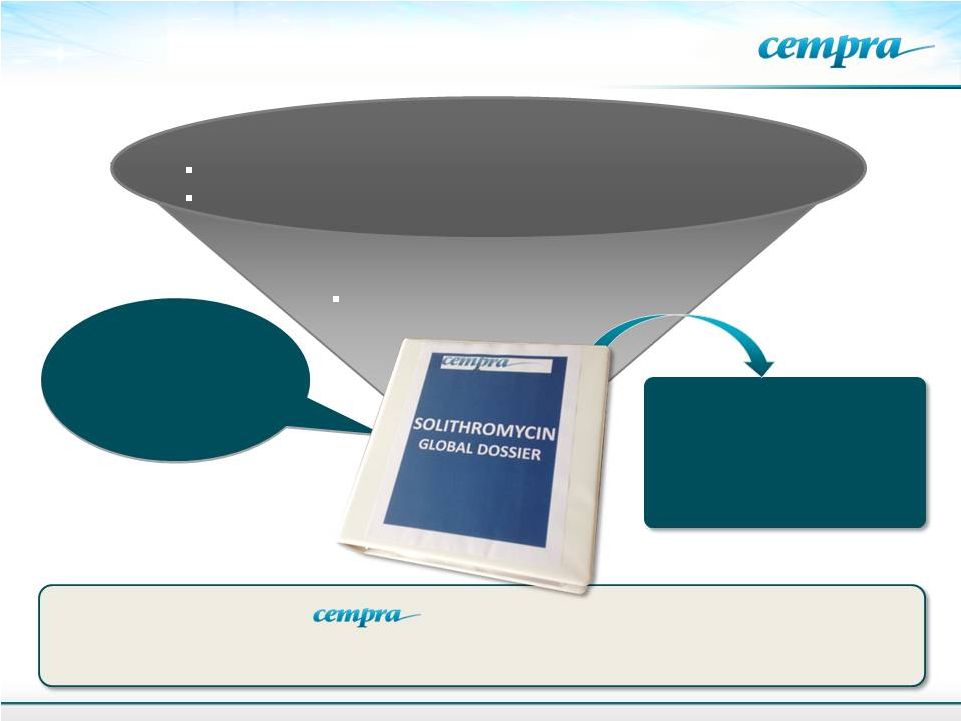 Pricing Models: U.S. & EU Countries A 4 th generation macrolide Branding – Product Recognition Clinical trial name is SOLITAIRE Mono-therapy Commercialization Activities 28 Solithromycin Value Proposition; Activity, Safety, different dosing formulations Market-specific Evidence Requirements for Access and Reimbursement Marketing & Sales U.S.: Co-promote with Partner EU: Partner Japan: Toyama/Fujifilm Pharmacoeconomic Advantages |